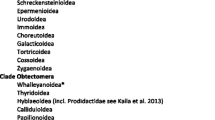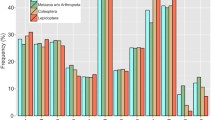Abstract.
We have studied the evolution of Gpdh in 18 fruitfly species by sequencing 1,077 nucleotides per species on average. The region sequenced includes four exons coding for 277 amino acids and three variable-length introns. Phylogenies derived by a variety of methods confirm that the nominal genus Zaprionus belongs within the genus Drosophila, whereas Scaptodrosophila and Chymomyza are outside. The rate of GPDH evolution is erratic. The rate of amino acid replacements in a lineage appears to be 1.0 × 10−10/site/year when Drosophila species are considered (diverged up to 55 million years ago), but becomes 2.3 × 10−10 when they are compared to Chymomyza species (divergence around 60 My ago), and 4.6 × 10−10 when species of those two genera are compared with the medfly Ceratitis capitata (divergence around 100 My ago). In order to account for these observations, the rate of amino acid replacement must have been 15 or more times greater in some lineages and at some times than in others. At the nucleotide level, however, Gpdh evolves in a fairly clockwise fashion.
Similar content being viewed by others
References
Archie JW (1989) Homoplasy excess ratios: new indices for measuring levels of homoplasy in phylogenetic systematics and a critique of the consistency index. Syst Zool 38:253–269
Ausubel FM, Brent R, Kingston RE, Moore DD, Smith JA, Seidman JG, Struhl K (1987) Current protocols in molecular biology. John Wiley, New York
Barrio E, Ayala FJ (1997) Evolution of the Drosophila obscura species group inferred from the Gpdh and Sod genes. Mol Phyl Evol 7:1–15
Beverley SM, Wilson AC (1984) Molecular evolution in Drosophila and the higher diptera. II. A time scale for fly evolution. J Mol Evol 21:1–13
Bewley GC, Cook JL, Kusakabe S, Mukai T, Rigby DL, Chambers GK (1989) Sequence, structure and evolution of the gene coding for sn-glycerol-3-phosphate dehydrogenase in Drosophila melanogaster. Nucleic Acids Res 17:8553–8567
Cook JL, Bewley GC, Shaffer JB (1988) Drosophila sn-glycerol-3phosphate dehydrogenase isozymes are generated by alternate pathways of RNA processing resulting in different carboxyl-terminal amino acid sequences. J Biol Chem 263:10858–10864
Csank C, Taylor FM, Martindale DW (1990) Nuclear pre-mRNA introns: analysis and comparison of intron sequences from Tetrahymena thermophila and other eukaryotes. Nucleic Acids Res 18: 5133–5141
Dayhoff MD (1978) Atlas of protein sequences and structure. National Biomedical Research Foundation, Washington, DC
DeSalle R (1992) The phylogenetic relationships of flies in the family Drosophilidae deduced from mtDNA sequences. Mol Phylogenet Evol 1:31–40
DeSalle R, Grimaldi DA (1991) Morphological and molecular systematics of the Drosophilidae. Annu Rev Ecol Syst 22:447–475 Felsenstein J (1981) Evolutionary trees from DNA sequences: a maximum likelihood approach. J Mol Evol 17:368–374
Felsenstein J (1989) PHYLIP—phylogeny inference package (version 3.2). Cladistics 5:164–166
Fitch WM (1971) Toward defining the course of evolution: minimum change for a specified tree topology. Syst Zool 20:406–416
Fitch WM, Ayala FJ (1994) The superoxide dismutase molecular clock revisited. Proc Natl Acad Sci USA 91:6802–6807
Grantham R, Gautier C, Gouy M, Mercier R, Pave A (1980) Codon catalog usage and the genome hypothesis. Nucleic Acids Res 8:r49–r62
Grimaldi D (1990) A phylogenetic revised classification of genera in the Drosophiliade. Bull Am Museum Nat Hist 197:1–139
awkins JD (1988) A survey on intron and exon lengths. Nucleic Acids Res 16:9893–9908
Higgins DG, Bleasby AJ, Fuchs R (1992) CLUSTAL V: improved software for multiple sequence alignment. Comput Appl Biosci 8:189–191
Jukes TH, Cantor CR (1969) Evolution of protein molecules. In: Munro HN (ed) Mammalian protein metabolism. Academic Press, New York, pp 21–132
Kawasaki ES (1990) Sample preparation from blood, cells, and other fluids. In: Innis MA, Gelfand DH, Sninski JJ, White TJ (eds) PCR protocols: a guide to methods and applications. Academic Press, San Diego, pp 146–152
Kimura M (1980) A simple method for estimating evolutionary rate of base substitution through comparative studies of nucleotide sequences. J Mol Evol 16:111–120
Kishino H, Hasegawa M (1989) Evaluation of the maximum likelihood estimate of the evolutionary tree topologies from DNA sequence data, and the branching order in Hominoidea. J Mol Evol 29:170–179
Kozak LP, Burkart DL, Hjorth JP (1982) Unlinked structural genes for the developmentally regulated isozymes of sn-glycerol-3-phosphate dehydrogenase in mice. Dev Genet 3:1–6
Kumar S, Tamura K, Nei M (1993) MEGA: molecular evolutionary genetics analysis, version 1.0. The Pennsylvania State University, University Park, PA 16802
Kwiatowski J, Skarecky D, Hernandez S, Pham D, Quijas F, Ayala FJ (1991) High fidelity of the polymerase chain reaction. Mol Biol Evol 8:884–887
Kwiatowski J, Skarecky D, Ayala FJ (1992a) Structure and sequence of the Cu,Zn Sod gene in the Mediterranean fruit-fly Ceratitis capitata: intron insertion and deletion in the evolution of the SOD gene. Mol Phyl Evol 1:72–82
Kwiatowski J, Skarecky D, Burgos M, Ayala FJ (1992b) Structure and sequence of the Cu,Zn superoxide dismutase gene of Chymomyza amoena: phylogeny of the genus and codon-use evolution. Insect Mol Biol 1:3–13
Kwiatowski J, Skarecky D, Bailey K, Ayala FJ (1994) Phylogeny of Drosophila and related genera inferred from the nucleotide sequence of the Cu,Zn Sod gene. J Mol Evol 38:443–454
Lakovaara S, Saura A, Lankinen P (1977) Evolution at the α-Gpdh locus in Drosophilidae. Evolution 31:319–330
Li W-H (1993) Unbiased estimation of the rates of synonymous and nonsynonymous substitution. J Mol Evol 36:96–99
Mount SM, Burks C, Hertz G, Stormo GD, White O, Fields C (1992) Splicing signals in Drosophila: intron size, information content, and consensus sequences. Nucleic Acids Res 20:4255–4262
O'Brien SJ, MacIntyre RJ (1972) The a-glycerophosphate cycle in Drosophila melanogaster. II. Genetic aspects. Genetics 71:127138
O’Brien SJ, MacIntyre RJ (1978) Genetics and biochemistry of enzymes and specific proteins of Drosophila. In: Ashburner M, Wright TRF (eds) The genetics and biology of Drosophila. Academic Press, New York, pp 395–551
Otto J, Argos P, Rossmann MG (1980) Prediction of secondary structural elements in glycerol-3-phosphate dehydrogenase by comparison with other dehydrogenases. Eur J Biochem 109:325–330
Powell JR, DeSalle R (1995) Drosophila molecular phylogenies and their uses. In: Hecht MK, MacIntyre RJ, Clegg MT (eds) Evolutionary biology, vol 28. Plenum Press, New York, pp 87–138
Russo CAM, Takezaki N, Nei M (1995) Molecular phylogeny and divergence times of Drosophilid species. Mol Biol Evol 12:391404
Saitou N, Nei M (1987) The neighbor joining method: a new method for reconstructing phylogenetic trees. Mol Biol Evol 4:406–425
Sharp PM, Cowe E, Higgins DG, Shields DC, Wolfe KH, Wright F (1988) Codon usage patterns in Escherichia coli, Bacillus subtilis, Saccharomyces cerevisiae, Schistosaccharomyces pombe, Drosophila melanogaster and Homo sapiens; a review of the considerable within-species diversity. Nucleic Acids Res 16:8207–8211
Starmer WT, Sullivan DT (1989) A shift in the third-codon-position nucleotide frequency in alcohol dehydrogenase genes in the genus Drosophila. Mol Biol Evol 6:546–552
Takano ST, Kusakabe S, Mukai T (1993) DNA polymorphism and the origin of protein polymorphism at the Gpdh locus of Drosophila melanogaster. In: Takahata N, Clark AG (eds) Mechanisms of molecular evolution. Japan Scientific Societies Press, Tokyo, pp 179–190
Takezaki N, Rzhetsky A, Nei M (1995) Phylogenetic test of the molecular clock and linearized trees. Mol Biol Evol 12:823–833 Tamura K, Nei M (1993) Estimation of the number of nucleotide substitutions in the control region of mitochondrial DNA in humans and chimpanzees. Mol Biol Evol 10:512–526
Templeton AR (1983) Phylogenetic inference from restriction endonuclease cleavage site maps with particular reference to the evolution of humans and apes. Evolution 37:221–244
Throckmorton LH (1975) The phylogeny, ecology and geography of Drosophila. In: King RC (ed) Handbook of genetics. Plenum Press, New York, pp 421–469
Tominaga H, Shiba T, Narise S (1992) Structure of Drosophila virilis glycerol-3-phosphate dehydrogenase gene and a comparison with the Drosophila melanogaster gene. Biochim Biophys Acta 1131: 233–238
von Kalm L, Weaver J, DeMarco J, MacIntyre RJ, Sullivan DT (1989) Structural characterization of the α-glycerol-3 -phosphate dehydrogenase-encoding gene of Drosophila melanogaster. Proc Natl Acad Sci USA 86:5020–5024
Wells RS (1995) Sequence and evolution of the Drosophila pseudoobscura glycerol-3-phosphate dehydrogenase locus. J Mol Evol 41:886–893
Wells RS (1996a) Nucleotide variation at the Gpdh locus in the genus Drosophila. Genetics 143:375–384
Wells RS (1996b) Excessive homoplasy in an evolutionarily constrained protein. Proc R Soc Lond [Biol] 263:393–400
Wheeler MR (1981) The Drosophilidae: a taxonomic overview. In: Ashburner M, Carson HL, Thompson JNJ (eds) The genetics and biology of Drosophila. Academic Press, New York, pp 1–97
Wilson AC, Carlson SS, White TJ (1977) Biochemical evolution. Annu Rev Biochem 46:573–639
Author information
Authors and Affiliations
Additional information
Received: 13 June 1996 / Accepted: 16 August 1996
Rights and permissions
About this article
Cite this article
Kwiatowski, J., Krawczyk, M., Jaworski, M. et al. Erratic Evolution of Glycerol-3-Phosphate Dehydrogenase in Drosophila, Chymomyza, and Ceratitis . J Mol Evol 44, 9–22 (1997). https://doi.org/10.1007/PL00006126
Published:
Issue Date:
DOI: https://doi.org/10.1007/PL00006126




